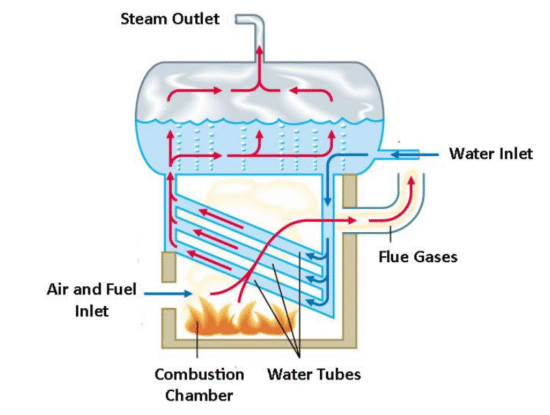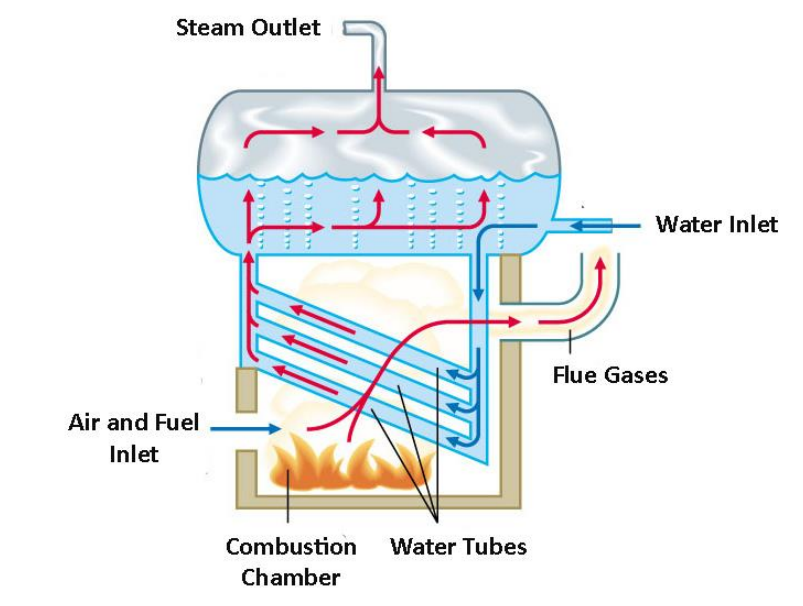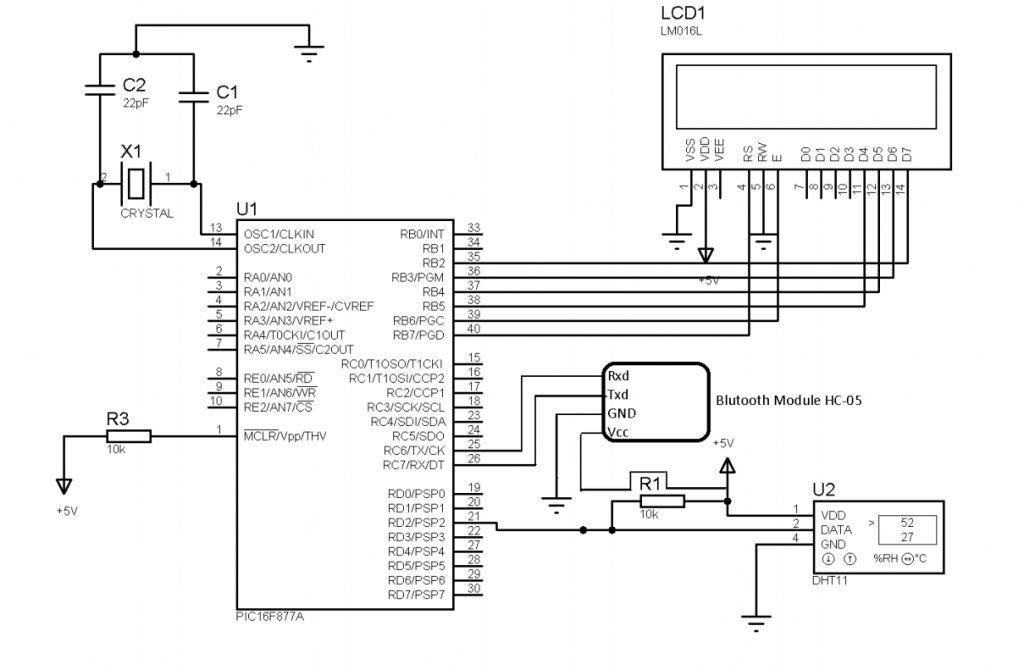
How to monitor temperature, pressure and water level of a boiler?
How to monitor temperature, pressure and water level of a boiler? Boiler is a closed vessel used to produce steam in many industries by applying heat energy to water. Industries are increasingly shifting towards automation. So there is a need to automate the boiler process. The main purpose of the report is to control the boiler drum level and quality of steam produced. In proposed system, the boiler parameters such as temperature, pressure, water level and state of steam are measured through a wireless sensor network and sent to the control unit for analysis. The microcontroller also displays the monitored data on an LCD and compares these values with the predefined range. If values exceed the specified range, it controls the parameters automatically. The microcontroller transmit the measured values using a Bluetooth module.
In past steam was merely used to run railway locomotives and turbines. But now in 21st century it has become an intrinsic and vital part of our modern technology. It is serving as base of our multimillion industries and is extensively used commodity for producing heat energy.
Conversion of Water to Steam
When temperature of water approaches its boiling condition, some molecules escape from liquid to space above the surface due to high kinetic energy. As temperature increases, the number of molecules leaving the liquid increases. Through the surface bubbles of steam rises at boiling point.
Consider the molecular arrangement of water and vapors. As we know that density of water is more than that of steam because steam molecules are free from each other. The space on the upper side of water surface is filled with steam molecules. Water will start evaporating when number of molecules escaping from surface is more than the molecules coming back to surface. This is boiling point or saturation temperature. At atmospheric pressure, the boiling point is 100°C. But if pressure is increased the temperature also increase without change of phase. It results in increase of enthalpy of water.
Enthalpy of Evaporation
The enthalpy of vaporization is also known as the heat of evaporation, is the energy that must be added to the substance, generally a liquid, to convert a quantity of that substance into gas form. Unit of enthalpy of vaporization is J/mol or kJ/mol.
Dryness fraction
This fraction is used to quantify the amount of water within steam. For example, if steam contains 15% water by mass, it’s said to be 85% dry, or have a dryness fraction of 0.85. Steam dryness is really important as it has direct correlation with the amount of transferable energy comprised by steam that governs quality and efficiency of heat.
Boiler
Boilers are the closed vessels which are used to produce steam or heat water. This steam can be used in many industrial systems. In certain applications such as absorption cooling textiles etc steam is preferred over hot water.
Working of Boilers
Working principal of boiler is simple and easy. Inside a boiler water is stored in a drum. In oil and gas fired boilers, combustion is carried out in the presence of mixture of oxygen and fuel. Combustion takes place in combustion chamber and heat reaches the water through heat exchanger

There are two heating element in electric heaters. Top heating element heats the upper tank and bottom heating elements heats it from the lower end. Electric heaters are easy to install and are quiet clean. Other advantages of these heaters include less maintenance cost and easy operation. Moreover if there is any fault in heating elements they can easily be replaced. The steam produced is then carried through pipes to
perform some specific task.
Classification of Boilers
Classification of boilers is done according to several factors explained below.
Size and Capacity
Sometimes a large boiler used for heating a building is replaced with small sized boilers in. It is done because these units can be arranged in many configurations and can be transported in elevator and stairways. The different configurations also add to the deficiency. These are known as Modular Boilers.
Working Temperature and Pressure of Boilers
Maximum pressure for low type boilers is usually 15 psig. Boilers with pressure above 15psig are considered to be high pressure boilers. These high pressure boilers are usually used in power generation plants. Limit of hot water boilers is up to 250 F.
Condensing Methods
Hot water boiler operates without condensing out water vapor from flue gas to prevent corrosion of boiler components. Boilers having low water temperature cause water vapor out of drain gasses. Condensing boilers remove additional heat and increases
boiler competence.
Safe Boiler Operation
For safe boiler operation, it is important to continuously monitor pressure and water level in boiler drum.
Importance of Water Level Control
If water level in boiler level goes too high or low, it can cause severe damages to the boiler. The details of harms due to poor level are given.
High Water Level Condition
If level of water in boiler exceeds the precise limit it may it may results in water carryover. When water goes above the center line of drum area decreased. Due to decrease in surface area, the water droplets go to steam heeder. If solids dissolved in boiler water it also resulted in carry-over. This carry- over of water resulted in transfer surfaces and steams itself.
Low Water Level Condition
When water level is low for longer period, tubes are not cooled by boiler water. It results in rapid increase of temperature which ultimately causes tube robust.
Effects of Pressure
Pressure is most important factor to control in steam boiler. If pressure rises above or falls below a specified level, series damage could be done. If steam pressure is low, according to Boyle’s law the volume increases and water level raised because bubbles of steam expand. On the other hand if steam pressure is raised above the limit, the water level falls because bubbles of steam compressed. In this case, boiler may be blast which results in serious damage or sometimes death of individuals. As water level rises above center line of drum, the surface area decreases. In design of boiler it is kept in consideration that water should be released at low velocity to avoid carry-over. If cool water enters a boiler drum, it condenses the bubbles inside the water drum and spoil their steam blanket. So it should also be consider while design that to absorb cool water without being affected by it.
Quality of Steam
Quality of steam is very critical factor to be considered. Steam should be 100% pure. At working areas steam should be available in correct quantity at particular temperature and pressure. It should be clean and dry. Steam quality should be 100% which means that there are no liquid components in the steam. If there are liquid components mixed with steam the quality of steam is low. Good quality steam or dry steam is useful in industrial systems. However wet steam destroys the steam boiler by damaging the tubes and turbines. For the measurement of steam quality the calculations of temperature pressure and humidity is needed.
Why Steam Quality is Important?
In modern age, heat transfer and control is improving its standard to provide the good quality products. To improve the quality each manufactured product is inspected repeatedly. Steam is a key part in all the manufactured products. That’s why steam quality is one of the most measurable factor.
As industries are increasingly shifting towards automation, there is a need to automate the boiler process control. Boiler control systems are implemented to control the water level and pressure of steam produced. Maintaining boiler drum level is important for constant production of steam. Similarly, the pressure control system should be is capable of taking appropriate actions such as shutting down or locking out burner
operation in high pressure situations.
Keyur Solanki and Jalpa Shah describe the modeling of two-element control of boiler drum level using PID controller. The first element keeps a check on the drum level while the other element measures the steam flow to provide mass balance of the water. Both of these elements send respective measurements to signal summer and the summed result is used to control the feedwater control valve. The system is able to sense demand fluctuations before water level changes. The controller automatically alters output to moderate the signal sent from first element i.e. drum-level controller. Steam flow generally being the larger variable, can outweigh the trim effect of the drum-level measurement, resulting in an accurate response.
Sanjoy KumarChakraborty, Nilotpal Manna and SurodhDey [5] describe the importance the three element control of drum level. The Three Element control is ideally suited in a situation where multiple boilers share the same feedwater header and a same supply system. This module is the combination of drum level measurement, feed flow measurement and steam flow measurement. To achieve optimum control, the core requirement is that both feedwater and steam flow values should be corrected for density. Feedwater flow controller uses steam flow as its set point and feedwater flow as its process variable. Feedwater is added in same proportion of steam leaving the boiler.
Andris Sniders and Toms Komass elaborate the Invariant Method of Load Independent Pressure Control in Steam Boiler. The research subject represents two loops of steam pressure and steam expenditure control with two loop invariant control system of the steam boiler, evolved in SIMULINK. The algorithm of the preemptive control circuit is arranged according to the invariant control principle in strong correspondence with the algorithms of power supply unit and steam boiler to set off the effect of fluctuations on the output.
The transfer functions and operational equations of the steam boiler control system units are build using mathematical analyses, operator mathematics and Laplace transforms. Transfer coefficients and time constants of the control system are calculated according to their technical parameters and operational conditions. For the purpose of simplicity, heat transfer in the steam boiler is evaluated as a process, where steam pressure changes uniformly with time. Then ordinary differential equations can be used to describe the transient process. The operational equations and transfer functions of automatic control system components is compiled,
Using Laplace transforms to differential equations.

Also read here
https://eevibes.com/pic16f4550-microcontroller/how-to-interface-stepper-motor-with-pic/